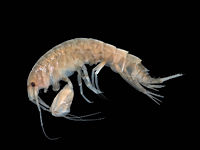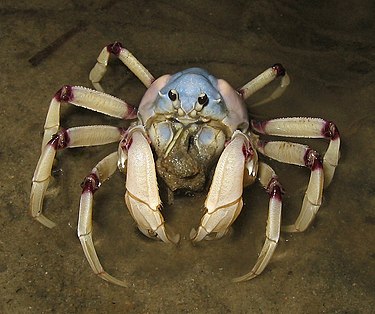The Crustaceans Portal Crustaceans are a group of arthropods that are a part of the subphylum Crustacea (/krəˈsteɪʃə/), a large, diverse group of mainly aquatic arthropods including decapods (shrimps, prawns, crabs, lobsters and crayfish), seed shrimp, branchiopods, fish lice, krill, remipedes, isopods, barnacles, copepods, opossum shrimps, amphipods and mantis shrimp. The crustacean group can be treated as a subphylum under the clade Mandibulata. It is now well accepted that the hexapods (insects and entognathans) emerged deep in the Crustacean group, with the completed group referred to as Pancrustacea. The three classes Cephalocarida, Branchiopoda and Remipedia are more closely related to the hexapods than they are to any of the other crustaceans (oligostracans and multicrustaceans). The 67,000 described species range in size from Stygotantulus stocki at 0.1 mm (0.004 in), to the Japanese spider crab with a leg span of up to 3.8 m (12.5 ft) and a mass of 20 kg (44 lb). Like other arthropods, crustaceans have an exoskeleton, which they moult to grow. They are distinguished from other groups of arthropods, such as insects, myriapods and chelicerates, by the possession of biramous (two-parted) limbs, and by their larval forms, such as the nauplius stage of branchiopods and copepods. Most crustaceans are free-living aquatic animals, but some are terrestrial (e.g. woodlice, sandhoppers), some are parasitic (e.g. Rhizocephala, fish lice, tongue worms) and some are sessile (e.g. barnacles). The group has an extensive fossil record, reaching back to the Cambrian. More than 7.9 million tons of crustaceans per year are harvested by fishery or farming for human consumption, consisting mostly of shrimp and prawns. Krill and copepods are not as widely fished, but may be the animals with the greatest biomass on the planet, and form a vital part of the food chain. The scientific study of crustaceans is known as carcinology (alternatively, malacostracology, crustaceology or crustalogy), and a scientist who works in carcinology is a carcinologist. (Full article...) Selected articleBarnacles are arthropods of the subclass Cirripedia in the subphylum Crustacea. They are related to crabs and lobsters, with similar nauplius larvae. Barnacles are exclusively marine invertebrates; many species live in shallow and tidal waters. Some 2,100 species have been described. Barnacle adults are sessile; most are suspension feeders with hard calcareous shells, but the Rhizocephala are specialized parasites of other crustaceans, with reduced bodies. Barnacles have existed since at least the mid-Carboniferous, some 325 million years ago. (Full article...) Did you know?
Selected biography
Robert Gurney (July 31, 1879 – March 5, 1950) was a British zoologist most famous for his monographs on British Freshwater Copepoda (1931–1933) and the Larvae of Decapod Crustacea (1942). He was born in 1879 as the fourth son of John Gurney and Isabel Charlotte Gurney (later Baroness Talbot de Malahide) of Sprowston Hall, Norfolk. He went to school at Eton College, and went on to study at New College, Oxford, graduating with first class honours in 1902. He was never associated with any institution, but worked from his home, initially in Norfolk, but later at Boars Hill. Realising the need for a specialist field station for freshwater biology to match the marine biological stations at Plymouth and Naples, Robert and his brother Eustace set up Great Britain's first freshwater laboratory at Sutton Broad. Gurney's two great study objects were the Copepoda and the larvae of Decapoda (zoea larva of Homarus gammarus pictured), and his greatest works were the three-volume monograph British Freshwater Copepoda, published by the Ray Society in 1931–1933, and his Larvae of Decapod Crustacea published by the Ray Society in 1942. Gurney travelled to North Africa and Bermuda, and received material from other foreign expeditions, including the Terra Nova Expedition (1910–1913) and the Discovery Investigations of the 1920s and 1930s.
Selected image Soldier crabs of the genus Mictyris, including M. longicarpus (pictured) congregate at low tide to feed by filtering mud. As the tide rises, they bury themselves, digging in a corkscrew pattern. General imagesThe following are images from various crustacean-related articles on Wikipedia.
Crustacean lists
SubcategoriesRelated portalsWikiProjectsAssociated WikimediaThe following Wikimedia Foundation sister projects provide more on this subject:
Discover Wikipedia using portals
Purge server cache
|
How Can We Help?























































Recent Comments